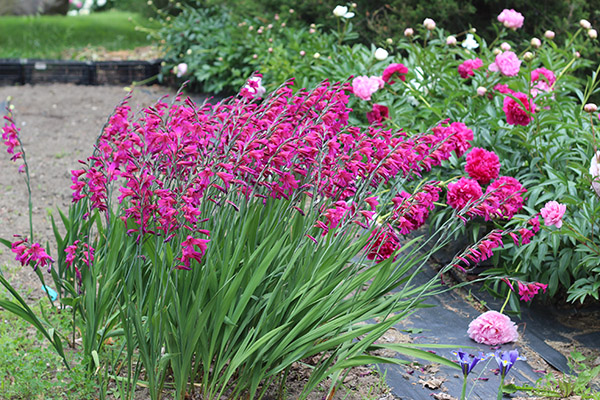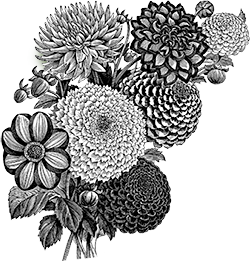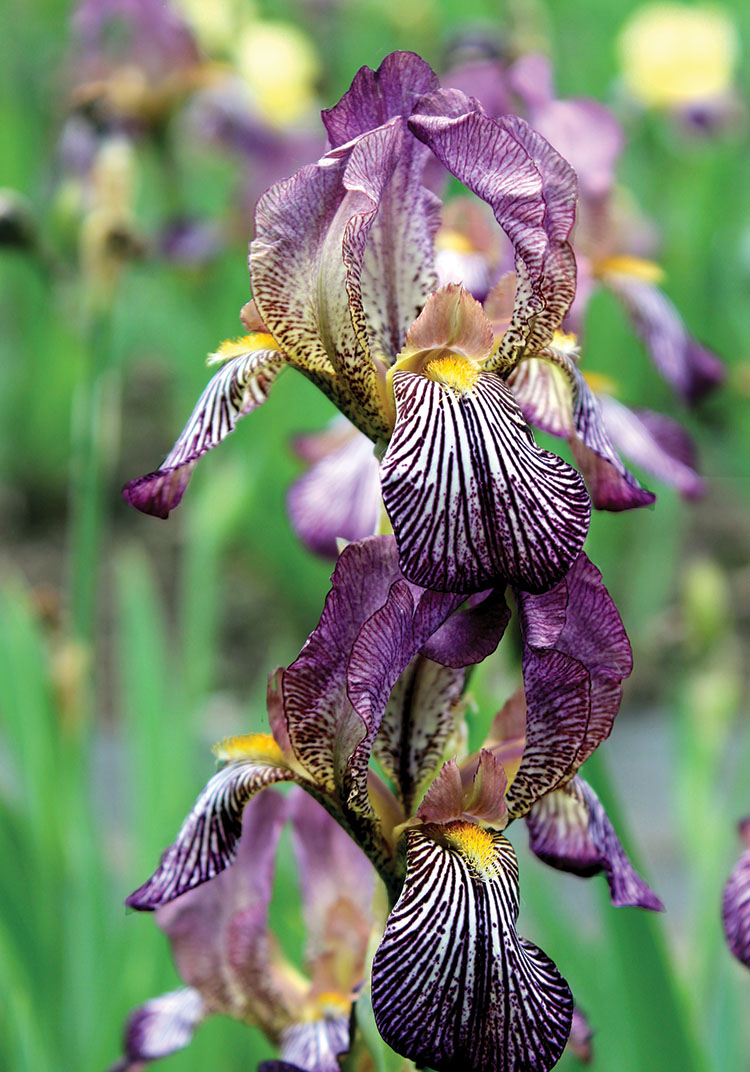|
“Almost any garden, if you see it at just the right moment, can be confused with paradise.”
– Henry Mitchell, 1924-1993, American garden writer and humanist
|
Summer Days are Here...
|

|
|
We’ve had an interesting start to summer here in Michigan as our weather has alternated between warm sunny days perfect for planting followed by late frost warnings and days that barely made it into the 50s, making us sorry we’d put away our extra layers – and then hot weather more appropriate to July! But through it all bloomed the late tulips, followed by the iris, then the peonies and now our beautiful Byzantine gladiolus - since they flower in early summer they’re planted in the fall, and unlike other glads are hardy in our zone 6a gardens! We hope you’ve had beautiful blossoms in your part of the country with lots of time for both garden projects as well as appreciating the results of all your past efforts.
|
…And Our Iris and Daylilies Have Been Thriving - More Varieties Now Available!
|
|
|
|
Not only have the flowers in our iris beds have been delightful, a number of varieties have increased enough that we’ve able to offer them for July shipping, though we didn’t have them this past spring. These include:
• Small-flowered burgundy ‘Colonel Candelot’ (1902)
• Long-blooming yellow ‘Coronation’ (1927)
• Glowing purple, fragrant ‘Crimson King’ (1893)
• Intricately-patterned ‘Demi-Deuil’ (1912)
• Treasured-by-early-herbalists ‘Florentina’ (1500s)
• Warmly-colored ‘Frank Adams’ (1932)
• Regal, fragrant ‘Her Majesty’ (1903)
• Vigorous, velvety ‘Indian Chief’ (1929)
• Elegant beauty ‘Mrs. Horace Darwin’ (1888)
• Charming, quick-to-increase ‘Quaker Lady’ (1859)
• And distinctively curvy, grape-scented ‘Swerti’ (1612)
Too many choices? Try our popular Immortal Iris sampler - we’ll send one each of three of our favourite varieties for an easy and pleasing collection!
Our daylilies have certainly been enjoying the warm spring rains! Five varieties that weren’t big enough this spring are now a perfect size:
• Lovely, long-blooming ‘Circe’ (1937)
• Rare, fragrant ‘lemon lily’ (1570)
• Brightly colored ‘Neyron Rose’ (1950)
• Cheerful little ‘Orangeman’ (1902)
• And last but not least, the dark, dramatic ‘Potentate’ (1943)
They’ll all arrive freshly dug and eager to put down new roots, so plan to plant them as soon as you can when your order arrives.
|
Don’t Forget Dad!
|
|
|
A very Happy Father’s Day to all the fathers, grandfathers and father-figures in our lives! Our gift certificates make great gifts for gardening guys and can be emailed to your loved one right away - or choose varieties from his birth year, graduation year, or other milestone and we - or you! - can send a card announcing that they’ll be arriving at the right time for planting.
|
Hey Wait, I Recognize That Flower!
|
|
|
We love flipping through a glossy garden magazine and spotting one of our historic varieties being used by contemporary garden designers – it’s so encouraging to see that heirlooms are being appreciated and recommended for a diverse audience! Here is a sampling of some of our favorites, featuring (since that’s what we’ve been reading lately) spring-blooming/fall-planted bulbs and companions.
When Fine Gardening asked horticulturists for some of their favorite plants, David Mattern of Chanticleer (a public garden in Pennsylvania) chose ‘Xit’ as one of his top four, saying “‘Xit’ is one of my favorite daffodils for naturalizing. The growth is not too vigorous, which is favorable in a meadow or minimally mown lawn; unlike some other daffodils, it won’t quickly grow into a dense clump creating unsightly, floppy foliage after flowering. With delicate, cool white flowers, this variety brings elegance to a spring design and pairs well with other soft, seasonal colors.” He adds “This daffodil looks great up close in a container or grown en masse, where it gives the impression of cumulus clouds.”
Gardens Illustrated profiled award-winning designer Jo Thompson with her suggestions for striking early spring containers. “Small spring bulbs are so beautiful, but their diminutive size means they can be easily overlooked in the garden, so it’s a really good idea to place them in containers, which can be positioned at a higher level.” She used Scilla siberica along with dwarf daffodils “to create the feeling of a tiny spring meadow full of these softly coloured gems of flowers.” In another, she combines Fritillaria meleagris with Viola ‘Konigin Charlotte’ and Muelenbeckia complexa, the last “dotted around the edges of the container, with the viola placed in between to create that all-important foundation for the show-stopping fritillary, the delicate, tall themes and long, thin, grey-green leaves of which bring height and form to the composition.” And its “nodding purple heads in an exquisite checkered pattern” echo the viola’s small purple-blue flowers for extra appeal.
The English Garden talked with three British bulb aficionados to see which bulbs they relied upon for their respective gardens. Sarah Pajwani, who has a two-acre country garden in Berkshire, uses two of our daffodils in her borders. Narcissus moschatus, “also known as the swan’s neck daffodil,...hangs its head demurely. This graceful beauty is short in stature and looks best in woodland areas where it can naturalise. The second, N. ‘Firebrand’ is, she says, “possibly my favourite daffodil of all with its star-shaped wavy lemon petals and a small fiery red cup.”
Mat Reese. “head gardener at Malverleys in North Hampshire” where he “has designed and developed a modern English flower garden over the past decade”. He says “Tulipa ‘Blue Aimable’ (sic) is, in my opinion, one of the best tulips to flower in mid to late May. Its flowers are an unusual dusky purple, with shades of blue within.” He likes Narcissus poeticus var. recurvus, “one of the last daffodils to flowers,...a white-flowered variety that looks good in a meadow or flower border.” For the woodland garden he too enjoys Silla siberica “a strong, self-sowing bulb that spreads to create sheets of blue pendent flowers.”
Last but not least Susie Pasley-Tyler uses lots of bulbs in her ten-acre garden in Northamptonshire including “clear blue Iris reticulata ‘Katherine Hodgkin’,...a dwarf iris for a sunny spot. It’s suitable for alpine areas or sinks…and needs gritty, well-drained soil to grow well.” She also suggests silver bells, Ornitholgalum nutans, which “has an unusual flower like a delicate form of silver-grey hyacinth”and blooms in May. For earlier bloom she likes Narcissus ‘Jenny’, “a delicate form of daffodil with white outer petals and a pale yellow trumpet, which flowers in March and early April” in her British garden.
And in an earlier issue they profiled Ann Bartleet of Bucklers Farmhouse in Essex where she has “a two-acre garden…made up of woodland, an orchard and meadow, a Dutch-style walled garden, a small knot garden and parterre, several pools and abundant borders that in spring are filled with colour from hundreds of tulips” of which deep purple ‘Negrita’ and contrasting ‘Bleu Aimable’ have prominent roles. Meanwhile Susan Rowley, head gardener for the Sizergh Castle in Cumbria, has developed a Stumpery which “is a picture in spring with late-flowering ivory ‘Thalia’ and leucojum“ along with “huge swathes” of muscari and ferns. N. ‘Thalia’, she says, with its “lovely cream and white flower, has naturalised…which helps with the informal relaxed feel.”
While we, along with many of you, garden on a substantially smaller scale, it’s a treat to find our beloved historic varieties showcased in so many different contexts!
|
Peonies in 1901: "A Well-Gloved Girl Who Can Swim and Ride"
|
|
|
|
The glorious abundance of the peony season we just enjoyed reminded us of Alice Morse Earle’s praise of them in her classic Old Time Gardens, Newly Set Forth. Published in 1901, Earle's book became enormously popular – a reminder today that we're not the first gardeners to appreciate heirloom plants.
"The glory of the front yard was the old-fashioned early red ‘piny’, cultivated since the days of Pliny. I hear people speaking of it with contempt as a vulgar flower – ‘flaunting’ is the conventional derogatory adjective – but I glory in its flaunting. The modern varieties, of every tint from white through flesh color, coral, pink, ruby color, salmon, and even yellow, to deep red, are as beautiful as roses. Some are sweet-scented; and they have no thorns, and their foliage is ever perfect, so I am sure the rose is jealous. . . .
"Not the least of the peony's charms is its exceeding trimness and cleanliness. The plants always look like a well-dressed, well-shod, well-gloved girl of birth, breeding, and of equal good taste and good health; a girl who can swim, and skate, and ride, and play golf. Every inch has a well-set, neat, cared for look which the shape and growth of the plant keeps from seeming artificial or finicky. . . .
"No flower can be set in our garden of more distinct antiquity than the peony; the Greeks believed it to be of divine origin. A green arbor of the fourteenth century in England is described as set around with gillyflower, tansy, gromwell, and ‘pyonys powdered ay betwene’ – just as I like to see peonies set to this day, ‘powdered’ everywhere between all the other flowers of the border."
If you’d like to give peonies a try for the first time, or if you’re thinking (as we do) that one can never have too many different peony varieties, take a break from summer chores by choosing some to plant this fall. We’ll send big, healthy American-grown rhizomes that will reward you - and those who come after you - for decades.
|
To Make Sure Our Newsletter Reaches You Safely . . .
|
|
|
Please add newsletter@oldhousegardens.com to your email address book or safe/approved list today.
|
To Unsubscribe
|
|
|
We hope you enjoy our monthly Gazette, but if not UNSUBSCRIBE here and we’ll drop you from our list immediately.
|
|
























